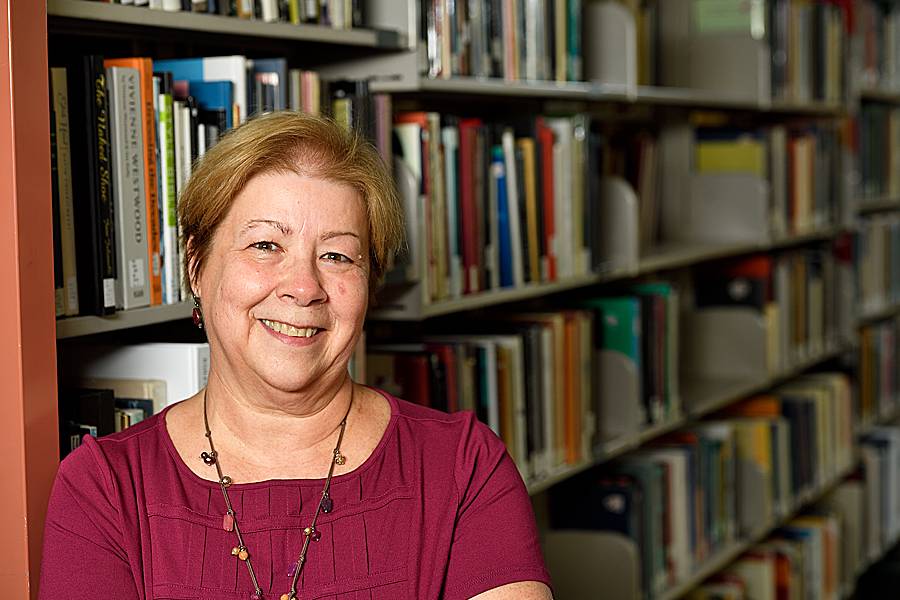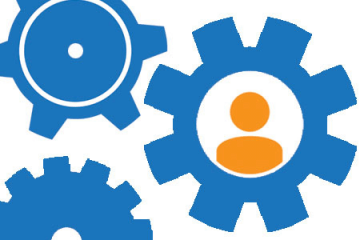Liz Mengel has a few million things to manage as the associate director of Collections & Academic Services of the Johns Hopkins Sheridan Libraries.
Under her directorate are the Academic Liaison librarians, Special Collections, Assessment and User Experience, Cultural Properties, Conservation and Preservation, Digitization, and Access Services. And then there's the matter of the books themselves, more than 4.2 million of them—housed across all Johns Hopkins library locations in Baltimore and Washington, D.C., and at the Libraries Services Center on the APL campus, where the majority are kept. And, of course, new books are published every week.
April 7 to 13 is National Library Week, whose theme this year is "Libraries = Strong Communities," a shoutout recognizing how libraries provide expertise and resources to the people they serve.
To see how that plays out at Johns Hopkins, we asked Mengel how the Sheridan Libraries select which titles will eventually end up in the collection—and found out that it takes a team of people to get the latest history book, novel, or collection of social science research placed on the libraries' shelves.
How do books get added to the collection?
I suspect people think that we have staff here looking through catalogs and buying books all day long. That hasn't happened in a really long time.
There's different pathways for the books to come into the library, based on the kind of book it is. And it really gets complicated because when people talk about books, they think of a single book, one idea cover to cover, and that's kind of it. In our language, that's a single-part monograph, meaning it's just one item, such as Bridges: The Science and Art of the World's Most Inspiring Structures by David Blockley.
But there's also big sets of work where a new volume may come out every year, or every two or three years—like Loeb Classics Library, which is a perpetually growing set of all that is important in Greek and Latin literature. Those things we call standing orders, and we try to get those set up so they're automatically shipped to us when they're printed.
The kind of normal print books that people think of for an academic library—Health and Social Justice by Jennifer Prah Ruger or Photograph: History and Theory by Jae Emerling—we use a number of approval vendors. We set up profiles with these vendors, and they look at all the books they get; if books match our profile, they're just sent here. So we have vendors for the major English-language publications, and for German, French, Italian, Spanish. We have a South American vendor, a Jewish vendor, a vendor that looks at all the small press titles and collections.
The other way that things come in is through our liaison librarians, our subject specialists. Our vendor profiles select books because they fit our profile, but there's also a secondary list of books that don't match everything in the profile. Those are what we call slips, and our subject specialists look online through those and see if there are additional titles to pick up.
The other way is if faculty members or grad students make suggestions. For faculty, we order just about anything that they request. It is as simple as letting their liaison librarian know, "Hey, this came out." We also have a profile set up to make sure we pick up all our JHU authors' books because we often don't know if someone doesn't tell us. And then, e-books are a whole other process.
How about popular books such as new novels, memoirs, and things that end up on best-seller lists?
We do have a collection of popular reading books and videos on the main level of MSEL that comes from a vendor specializing in current reading. We get new books and videos in every few months. The books are rented, but we have the option to buy them if we think they would be good to add to the collection.
Is this selection happening on a monthly, or quarterly, basis?
It's a continual process. We get boxes every day, from all these different vendors. They come into our Technical Services Department, which is up in Mount Washington. They come in, they're unboxed, and they're cataloged. Once they are cataloged, our Collections Services staff will deliver them to their appropriate shelving location for people to use. We work really hard to get material from order to shelf as quickly as possible.
Do you have a rough estimate for how many new books enter the collection?
We're running between 20,000 and 25,000 a year for books but closer to a total of 100,000 volume equivalents when you include other types of content such as university records, archives, manuscripts, etc. We also buy books that are rare or unique and will go into Special Collections. If it's very old or a one-of-a-kind artist's book, those are usually ordered by our curators, who work closely with rare and antiquarian book dealers. We let the dealers know what kinds of things we're looking for. And sometimes our curators have made acquaintance with people who have unique collections that they may want to give to the university at some point. Then we work with our Development Office to steward that person to be able to bring those collections to the libraries.
Does the steady stream of new titles affect what stays in the MSEL and what goes offsite?
For the new books, almost all of them come to the MSEL almost right away. [Those that go] out to the Library Services Center are likely to be less used or that need special protection.
Do books ever leave the collection?
Usually, as a research library, we try not to get rid of anything. But space does become an issue, and we're trying to manage those needs, both here and offsite. And we're working really closely with our Ivy Plus library partners to start thinking about how we develop shared collections, where we might buy more heavily in one area and someone else would buy more heavily in another, and then we're able to move the books back and forth through our BorrowDirect service.
The kinds of spaces needed on campus in the library are starting to become different than they had been years ago, especially with so much content online. We keep fewer print journals in the library than we used to, given so many are now electronic. And like many libraries, we have deaccessioned print copies of journals that we have electronically, but only those that we know have good archives of both the print and the digital. Sometimes people still want to see the print copy, and we try to make sure we can fill that need.
We will look at books that maybe have been damaged, and if we can't replace them and we don't think the content supports the research and teaching here anymore and we can't really fix it, those may be deaccessioned.
It is actually quite a decision-making process to deaccession something. It's not something we take lightly at all. Most of us have spent years and years building up this collection, so if we're going to move something out or not have it anymore, we think really hard about it and try to understand the longer-term impact of what we do.
I can only imagine, because librarians have to think about what's going to be important for researchers in the future.
Our liaison librarians work really hard to understand what areas faculty are doing research in, what they are thinking about for the future. We try to understand what's going on in broader publishing trends and look at how those trends impact what we might be bringing in and how that may affect the use of our collection. We try to understand which publishing areas are growing and which areas are declining. How do we balance what we have in print versus what we have electronically? We know that the print and the electronic book are not used the same way. You can't really afford to have a complete duplication, but there are times when you need both, so we try to figure out when we need that and when we don't.
So there's a lot of moving parts involved with bringing new books to the library. If you tracked one book from the idea of ordering it to when it's actually checked out, it goes through a lot of different people. Our goal is to get a book on the shelf as soon as possible so it's available for people to use.
Posted in News+Info
Tagged sheridan libraries, who does that?









